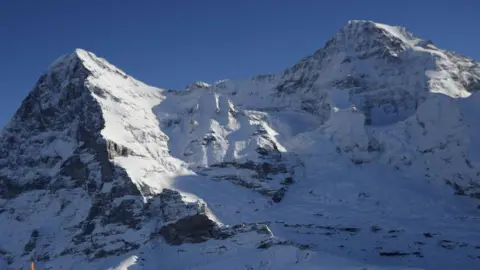In a remarkable operation, Swiss authorities have successfully rescued all individuals buried under a significant avalanche that struck the Eiger mountain on Saturday afternoon. This event has drawn attention not only due to its dramatic nature but also because of the rapid and efficient response from emergency services. The avalanche occurred around midday, prompting a large-scale rescue operation from the Bern Cantonal police, which later reported that all trapped individuals had been flown out without any casualties or missing persons, although the number of individuals involved was not specified.
The Eiger is a notable peak in the Swiss Alps, rising to a height of 3,967 meters (approximately 13,000 feet). It holds a special place in both the hearts of mountaineers and vacationers visiting regions such as Grindelwald, Lauterbrunnen, and Wengen, popular tourist destinations known for their breathtaking views and outdoor activities. The avalanche serves as a stark reminder of the natural dangers present in these stunning yet volatile mountain environments.
Shortly after the avalanche, multiple rescue teams were deployed to conduct search operations. The chaos and urgency of the situation were met with coordinated efforts from local police and rescue services, showcasing their preparedness and commitment to safety in the face of natural disasters. By Saturday evening, the official statement from the police reassured families and communities that all individuals had been accounted for, resulting in a collective sigh of relief from those who may have feared the worst.
The Eiger has long been synonymous with both adventure and peril; it is especially famous among climbers due to its notorious north face, which poses significant challenges and dangers. The wall is known for its sheer verticality and harsh weather conditions, making it a coveted ascent for skilled mountaineers. The recent avalanche is a poignant reminder of nature’s unpredictable power and the risks involved in alpine sports.
Meanwhile, the local community and authorities are likely to reflect on this event and its implications for safety protocols during the winter season. Avalanches pose a persistent threat in the Alps, particularly in areas where skiing and climbing are popular. The authorities may consider enhancements in their avalanche warning systems and public safety measures to ensure that such incidents are mitigated in the future.
This incident underscores the ongoing challenge of balancing adventure sports with safety in mountainous regions. As tourism continues to rise in the Swiss Alps, consistent education on avalanche risks and the necessary precautions is vital for both visitors and locals. Increased awareness through training on how to respond in emergencies could be crucial in preventing future tragedies.
In conclusion, the successful rescue operation following the avalanche on the Eiger mountain stands as a testament to the high level of training and preparedness among Swiss emergency services. Their quick response likely saved lives and demonstrates the importance of effective communication and collaborative efforts among various rescue teams. While the event serves as a powerful reminder of the beauty and danger of the alpine environment, it also highlights the need for ongoing vigilance and enhanced safety measures in outdoor recreational activities. As the community embraces the upcoming winter season, it will undoubtedly carry forward these lessons learned in the face of nature’s formidable forces.



